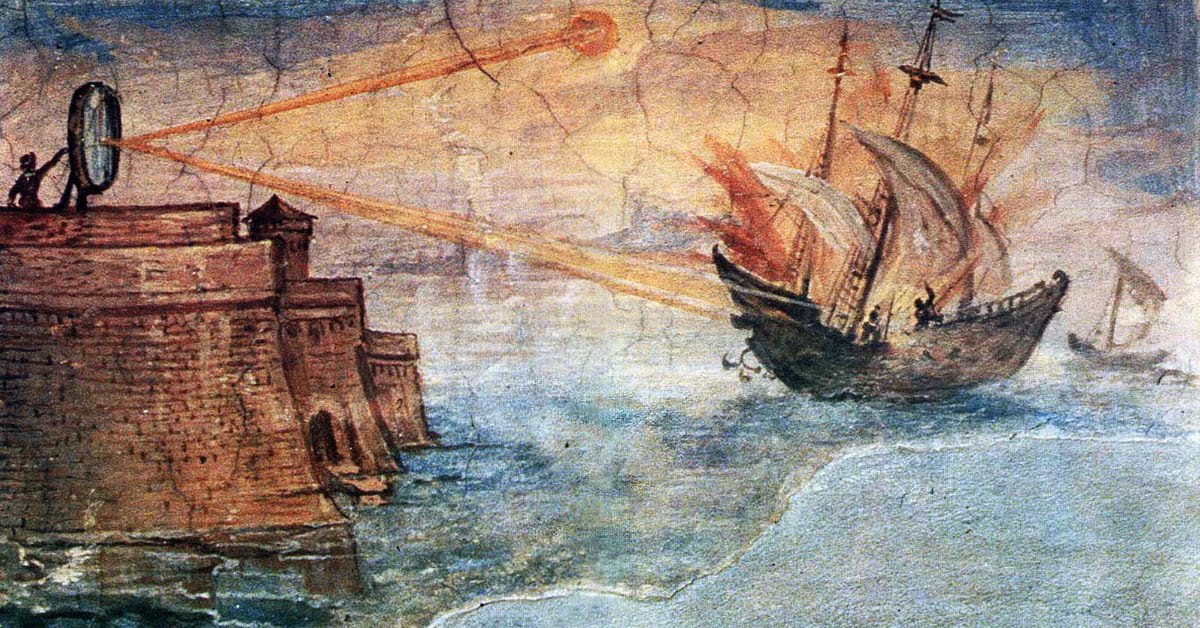According to popular historical legend, the famous ancient Greek scientist defended his native Syracuse and created a system of mirrors, thanks to which the rays of the sun ignited the hulls of Roman warships.
This is what Vladimir Fortunatov writes about this case in his book “World history in faces": "The creativity of Archimedes was clearly manifested in military affairs. He first built loopholes in the walls, and yet firearms appeared only one and a half millennia after his death! He is credited with creating ray weapons: with the help of thousands of mirrors, Archimedes managed to focus the rays of the sun and direct them at the enemy’s wooden ships, which burned down. In Syracuse, besieged by the Romans, there were throwing machines that accurately hit the enemy. Mighty “iron paws” extending from the fortress captured enemy ships and turned them over. In modern scientific documentaries one can find reconstructions of Archimedes' inventions and understand the indignation of Titus Livy. Such people cannot be killed. In the worst case, they can be kept in sharashkas, as Stalin and Beria did.”
The poet addressed the legend in his works Valery Bryusov. She is mentioned "Gazeta.ru", "RBC", "Russian newspaper", "Radio Liberty", Lenta.ru and many other media.
Siege of Syracuse by the Roman army lasted about two years (214–212 BC) and ended with the capture of the ancient Greek port. Archimedes, according to a number of sources, who participated in the defense of his hometown, was killed by a Roman soldier after the siege.
In the works of ancient historians from the time of Archimedes that have come down to us, there is no mention of his mirrors. In three famous accounts of the storming of Syracuse - Polybius (II century BC), Tita Livia (1st century BC) and Plutarch (1st century AD) - the use of fire does not appear at all. Plutarch mentions defensive machines designed by Archimedes, but he is talking about throwing stones and arrows. But the Greek satirist Lucian reportsthat Archimedes “using his art burned the enemy ships.” To him echoes and the Roman physician Galen: “They say that Archimedes also set fire to the enemy’s triremes with incendiary mirrors.” Both authors lived in the 2nd century AD. BC, when the legend of mirrors apparently gained great popularity.
The description of the mirror structure was preserved in two free Byzantine retellings of a part of the “Roman History” that has not reached us. Diodorus Siculus - historian of the 1st century BC. e.
1. “Archimedes... burned the Roman fleet in the most incredible way. Pointing a special kind of mirror at the Sun, he collected beams of its rays and, thanks to the thickness and smoothness of the mirror, managed to ignite the air with sunlight so that a colossal flame arose. He directed the rays at the anchored ships, and they burned to the ground.”
2. “When Marcellus removed the ships to a distance exceeding the flight of an arrow, the old man built a special hexagonal mirror; At a distance proportional to the size of the mirror, he placed similar quadrangular mirrors, which could be moved using special levers and hinges. He turned the mirror to the midday sun - winter or summer - and when the beams of rays were reflected in it, a huge flame flared up on the ships and, from the distance of an arrow, turned them into ashes.
Later Byzantine scholar of the 6th century Anthimius of Thrall developed and even, according to a number of sources, built a system of 24 burning mirrors. However, there is no reason to believe that the mirrors of Anthimius were identical to the mirrors of Archimedes, if the latter existed at all.
In modern times, one of the first attempts to implement the Anthemia system was made by the German mathematician and philologist Athanasius Kircher. In a treatise published in 1646 "The Great Art of Light and Shadow" he reports that he tried to combine the reflection of the sun from five flat mirrors and obtained significant heating, although not enough to ignite the tree. Here it is necessary to clarify that Archimedes, according to Kircher, had to use a beam of concentrated rays, supposedly capable of lighting a tree at any distance.
But 40 years before Kircher’s publication, the famous French mathematician Rene Descartes in his “Dioptrics” proved that it was impossible to bring the sun’s rays to one point, as well as to create a parallel beam of burning rays. “An incendiary mirror, the diameter of which is less than a hundredth part of the distance between it and the place where the sun’s rays are concentrated... even if it were polished by an angel, cannot... heat that place more than the rays emitted directly by the sun, - writes Descartes. - Only people who are not very knowledgeable in optics are convinced of the reality of many fables; these mirrors, with the help of which Archimedes allegedly burned ships from afar, were either extremely large, or, more likely, did not exist at all.”
A century later, the famous naturalist Georges-Louis Buffon addressed this topic. In his work, “The Invention of Mirrors for Igniting Objects at Long Distances,” he described a series of experiments in which he achieved some success—even setting fire to a tarred spruce board at a distance of 150 feet (45 m) using 128 mirrors.

The experiments of Buffon, a fairly influential scientist of his time, revived the extinct interest in the story of Archimedes' mirrors. And so, at the end of the 20th and beginning of the 21st centuries, representatives of modern science decided to give their answer to a question that has been troubling many generations.
In “Reflections on Archimedes' Burning Mirrors,” published in the 1992 European Physical Journal, scientists Mills and Clift calculated: to simply make wood smolder at a distance of 50 m, you will need 440 flat mirrors with an area of 1 m2 each. However, even in this case, a smoldering tree can be easily extinguished by dousing it with salt water. Scientists doubted that in 214 BC. e. in Sicily, as many as 440 mirrors could have been produced, perfectly polished and effectively used, despite the fact that this was a rare and scarce commodity during Antiquity.
Cesare Rossi, mechanical engineer from the University of Naples, believesthat the mirrors were unlikely to maintain proper focus on ships that not only moved through the water, but also rocked on the waves. He calls Archimedes' use of a steam gun much more likely. Such guns could fire hollow balls of clay filled with an incendiary chemical mixture - “Greek fire”. When heated, the cannon barrel would convert 30 grams of water into enough steam to propel an entire projectile. Many years later, another great scientist and artist, Leonardo da Vinci, depicted and attributed a similar cannon to Archimedes.

In October 2005, a group of MIT students conducted an experiment with a mock-up of a wooden ship at a distance of about 100 feet (30 m). The flames were ignited with great difficulty - only after the sky became cloudless and the ship remained motionless for about ten minutes. Later, the same people repeated the experiment for the famous TV show MythBusters, using a wooden fishing boat in San Francisco as a target. And again in the end succeeded achieve charring and a small flame. However, in the end, the experiment fell into the “failed” category for a number of reasons, namely:
1) Syracuse, where the legend takes place, faces east. Therefore, their inhabitants were unable to take advantage of the most intense midday rays, relying instead on the less powerful morning rays.
2) “Mirrors of Archimedes” are useless in even slightly cloudy weather.
3) Most likely, the enemy ships were in motion, so the mirrors had to be refocused every second.
4) Neither fire nor mirrors were mentioned for a long time in historical sources when describing the battle.
5) To set fire to ships would have required a huge amount of mirrors and auxiliary equipment for those times.
The MythBusters team concluded that it would be much more effective to use regular flaming arrows or similar Molotov cocktails. It should be noted that this was the second attempt by the creators of the program to confirm the myth, however, it was also the first in its time failed. And in 2010, US President Barack Obama called The creators of the show are conducting their third experiment. This time, 500 schoolchildren tried to focus the mirrors on the sail of a model of a Roman ship, which was located at a distance of 120 m from them. However, the sail was never able to reach the temperature of 210 °C required for ignition. The program decided that the main effect of the mirrors could have been blinding or distracting the ship's crew.
Thus, both the majority of modern experiments (requiring compliance with a number of conditions) and the lack of information about Archimedes’ mirrors in the most ancient sources about the siege of Syracuse indicate one thing: most likely, this legend has no basis in reality.
Most likely not true
Read on topic:
1. Reflections of the “Burning mirrors of Archimedes”
2. Study: Archimedes Set Roman Ships Afire with Cannons
3. The Legend of the Burning Mirrors
If you find a spelling or grammatical error, please let us know by highlighting the error text and clicking Ctrl+Enter.







